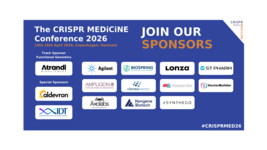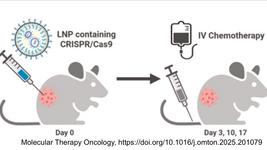CMN Weekly (7 November 2025) - Your Weekly CRISPR Medicine News
By: Gorm Palmgren - Nov. 7, 2025
Top picks
- Caribou Biosciences reports positive Phase 1 results for vispa-cel, an off-the-shelf anti-CD19 CAR-T therapy for relapsed/refractory B-cell lymphoma, showing efficacy comparable to autologous CAR-T with an 82% overall response rate and 64% complete response rate in second-line patients with optimised HLA matching. The therapy demonstrated a favourable safety profile suitable for outpatient administration, and the company plans to advance to a pivotal Phase 3 trial following guidance from the FDA.
- PIE (prime editing-based inversion with enhanced performance) is a new genome editing tool that creates precise genomic inversions from kilobase to chromosomal scale in mammalian cells. PIEv3b utilises four concatenated pegRNAs to achieve up to 20-fold higher efficiency compared to existing methods, such as Cas9 dual sgRNA and other prime editor approaches, with improved accuracy and fewer byproducts. The system successfully converted human chromosomes from metacentric to telocentric configuration. While PIEv3b produces small deletions at inversion junctions rather than seamless edits, it enables efficient disease modelling and holds promise for correcting pathogenic inversions.
Research
- Researchers engineered large serine recombinases (LSRs) using directed evolution, structural analysis, and dCas9 fusions to enhance genomic integration without the need for landing pads. Top variants (superDn29-dCas9, goldDn29-dCas9, hifiDn29-dCas9) achieve 53% integration efficiency and 97% specificity, successfully inserting DNA up to 12 kb in non-dividing cells, stem cells, and primary T cells for gene and cell therapies.
- DNA double-strand breaks (DSBs) leave persistent chromatin alterations even after complete DNA repair, Danish researchers have discovered. Using Cas9-induced breaks and multiple genomic readouts, they found that DSB-induced changes in 3D chromatin structure and gene expression fail to recover to pre-damage levels, persisting through multiple cell divisions as "chromatin fatigue." This has functional consequences, such as reduced c-MYC responsiveness to signalling, revealing a heritable dimension of DNA damage responses with implications for cells experiencing environmental stress or nuclease-based genome editing.
- Researchers developed hybrid guide RNAs with DNA nucleotide substitutions to improve the safety of adenine base editing therapies for three genetic liver disorders: PKU, PXE, and HT1. These modified gRNAs dramatically reduced off-target and bystander editing while maintaining therapeutic efficacy in human hepatocytes and mouse disease models. When delivered via lipid nanoparticles with ABE mRNA, the optimised hybrid gRNAs successfully reversed disease phenotypes with enhanced precision and efficiency.
- CLEAR-time dPCR is a comprehensive multiplexed digital PCR method that tracks DNA repair processes following CRISPR editing in human stem and T cells. The technique quantifies up to 90% of loci with unresolved double-strand breaks, revealing that conventional mutation screening assays significantly underestimate aberrations. Notably, the method uncovered that error-free DNA repair is highly prevalent after nuclease cleavage, with repeated cycles of precise repair and recurrent cutting occurring before mutations accumulate.
- A novel temperature-activated Cas12a-based sterile insect technique (pgSIT) utilises a single strain that contains both Cas12a nuclease and gRNAs targeting male sterility and female lethality. Unlike traditional pgSIT, which requires two separate lines and sorting, this system maintains mixed-sex populations at low temperature. It activates at higher temperatures to produce sterile males in one generation, offering a more scalable approach for vector control.
- Researchers have developed a collection of engineered cytidine deaminases that enable efficient C-to-U RNA base editing across diverse sequence contexts, demonstrating therapeutic potential by correcting disease-causing mutations in mouse models of hypercholesterolaemia and autism spectrum disorder. The system, which combines AI-designed enzymes with programmable RNA-binding proteins, achieves editing rates of up to 68% in vivo without detectable DNA modifications. Also, read our take on the story.
- CRISPR-based paired prime editing has been used to generate over 10,000 precise genomic deletions, enabling large-scale dissection of genome function. Their screens identified key efficiency factors and revealed 462 non-coding regions affecting cell fitness. Most surrounding non-coding DNA appeared dispensable for growth, suggesting new therapeutic possibilities and demonstrating the scalability of prime editing for functional genomics.
- An updated CRISPR-Cas classification now includes two classes, seven types, and 46 subtypes (expanded from six types and 33 subtypes five years ago), as well as a new type III cyclic oligoadenylate signalling pathway classification. Recently characterised variants include type IV systems that cleave target DNA and type V systems that inhibit replication without cleavage. While previously defined systems are common, newer variants are comparatively rare and form a "long tail" requiring experimental characterisation.
- Researchers used a cytosine base editor (CBE) to knock out SOCS2 in C2C12 myoblasts, achieving 53% editing efficiency with a premature stop codon at amino acid 19. SOCS2 knockout elevated Growth Hormone Receptor (GHR) expression and significantly enhanced myoblast differentiation, increasing myogenic markers MyoD1, MyoG, and MYH1. The knockout activated the PI3K/AKT/mTOR signalling pathway, revealing SOCS2's regulatory role in skeletal muscle development.
- CRISPR PRO-LiveFISH is a novel technique that combines orthogonal bases and rational sgRNA design to label multiple non-repetitive genomic loci in living cells efficiently. The method simultaneously images up to six loci using just 10 sgRNAs without signal amplification, works in diverse cell types, including primary cells, and reveals enhancer-promoter dynamics, correlations between genomic dynamics and epigenetic states, persistent PCDHα-enhancer interactions, and BRD4's role in maintaining super-enhancer contacts regulating MYC expression in cancer cells.
Screening
- Using a genome-scale CRISPRi screen with a live-cell AR reporter, researchers have identified PTGES3 as a key modulator of AR protein stability in prostate cancer. PTGES3 repression destabilised AR, impaired AR target gene activity, and induced cell death. Its expression correlated with resistance to AR-directed therapies, positioning PTGES3 as a potential target to overcome treatment resistance in AR-driven prostate cancer.
- CRISPR activation (CRISPRa) screening has identified a cilia disassembly pathway involving F2R receptor, SARM1, ryanodine receptors, calcium signalling, and RhoA. Components of this pathway are somatically mutated in focal cortical dysplasia (FCD), a neurological disorder with intractable epilepsy. Patient-derived SARM1 and RhoA mutations increase cilia loss and impair cortical development, while SARM1 inhibition restores cilia in FCD cells, demonstrating how CRISPRa screening can illuminate diseases caused by somatic mutations.
Clinical & preclinical
- Caribou Biosciences has reported phase 1 data for CB-011, an off-the-shelf anti-BCMA CAR-T therapy for multiple myeloma. At the recommended dose, CB-011 achieved an overall response rate of 92%, a complete response rate of 75%, and a MRD negativity rate of 91%, with the longest responder at 15 months. The therapy utilises immune cloaking via B2M knockout and B2M-HLA-E fusion to prevent rejection, demonstrating manageable safety with no graft-versus-host disease, and is advancing to a dose expansion.
Industry
- Azalea Therapeutics has launched with $82 million in funding to develop in vivo CAR-T therapies using a dual-vector system that delivers transient CRISPR-Cas9 and promoterless templates. Their EDV platform enables targeted, site-specific gene insertion in T cells under endogenous promoter control, thereby eliminating the need for ex vivo manufacturing. This approach demonstrated durable CAR expression in vivo, providing a scalable and precise strategy for cancer and autoimmune treatment.
Third Quarter 2025 Financial Results
- Sangamo Therapeutics reports Q3 net loss of $33 million and a cash deposit of $30 million.
- Vertex reports Q3 net income of $1.1 billion and a cash deposit of $12 billion.
- Sangamo Therapeutics reports Q3 net loss of $35 million and a cash deposit of $30 million.
- Precision BioSciences reports Q3 net loss of $22 million and a cash deposit of $71 million.
- LENZ Therapeutics reports Q3 net loss of $17 million and a cash deposit of $202 million.
- Intellia Therapeutics reports Q3 net loss of $101 million and a cash deposit of $670 million.
- Beam Therapeutics reports Q3 net loss of $113 million and a cash deposit of $1.1 billion.
- Allogene Therapeutics reports Q3 net loss of $41 million and a cash deposit of $277 million.
Perspectives
- Two new biotech ventures pursuing heritable genome editing in embryos have raised concern among scientists, reigniting unresolved debates about safety, ethics and public oversight. A Nature News & Views piece highlights how this signals shifting attitudes – but also how far the field still is from clinical readiness. Also, read our roundup of the story.
- Researchers at Children's Hospital of Philadelphia and University of Pennsylvania describe their FDA regulatory strategy for personalised gene editing platforms following the successful treatment of an infant with a rare urea cycle disorder. The FDA agreed that a single toxicology study can cover multiple patient-specific variants, with new variants added via in vitro data only. The agency supports "umbrella" master protocol trials enabling efficient development across PKU and seven urea cycle disorders, with the primary IND submission planned for 2026.
To get more CRISPR Medicine News delivered to your inbox, sign up to the free weekly CMN Newsletter here.
“The European Genomic Medicine Consortium is quietly gathering under the CMN umbrella. Exploring the frontier of gene editing for therapeutic precision - this network is not public yet, but it’s real. Watch the signals, track the sequences. Only those who search will know.”R
Tags
ArticleNewsCMN WeeklyEli LillyFate Therapeutics, Inc.Intellia Therapeutics, Inc.
CLINICAL TRIALS
IND Enabling
Phase I
Phase II
Phase III
Gastric Cancer and Colorectal Cancer, CRC, (NCT07166263)
Sponsors:
Base Therapeutics (Shanghai) Co., Ltd.
Sponsors:
Base Therapeutics (Shanghai) Co., Ltd.
IND Enabling
Phase I
Phase II
Phase III
Relapsed or Refractory Acute Myeloid Leukemia, AML, (NCT06541444)
Sponsors:
Base Therapeutics (Shanghai) Co., Ltd.
Sponsors:
Base Therapeutics (Shanghai) Co., Ltd.
IND Enabling
Phase I
Phase II
Phase III







